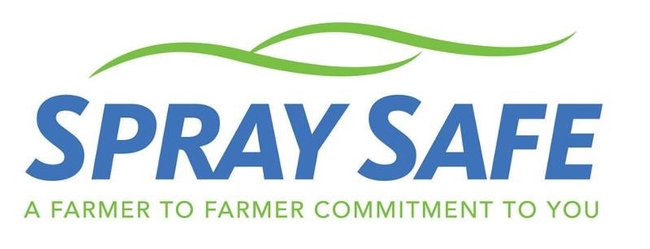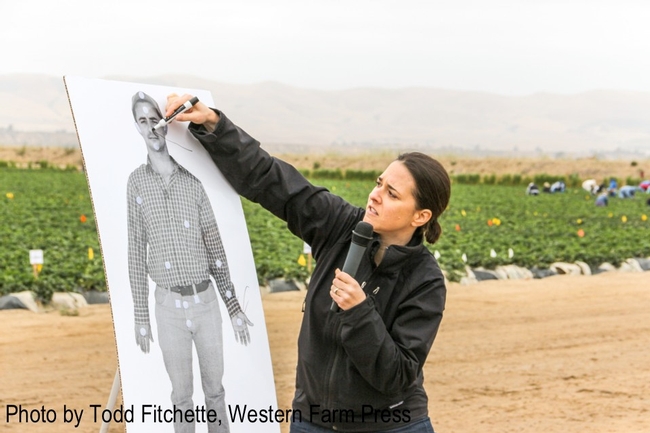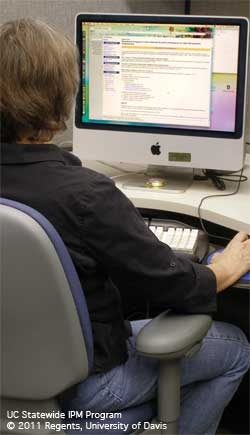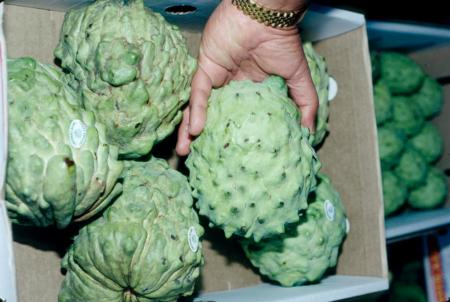- Author: Ben Faber
Spray Safe registration opens
Registration is now open for the sixth Ventura County Spray Safe event. This year's keynote speaker will be Brian Leahy, director of the California Department of Pesticide Regulation.
The event will be on Tuesday, March 20, in the Agriculture Building (Santa Cruz Hall) at the Ventura County Fairgrounds, 10 W. Harbor Blvd., Ventura.
Program
7:30-8:30 a.m.: Registration
8:30-11:50 a.m.: Presentations
11:50 a.m.-12:45 p.m.: Lunch (provided)
12:45-1:30 p.m.: Speakers
Spray Safe is intended to prevent pesticide-exposure incidents and improve communication among growers, agricultural chemical applicators and farm employees. Originally developed by a coalition of farmers, pest control advisers, applicators and labor contractors concerned about drift incidents in Kern County, the program is being embraced by growers throughout California as a way of better protecting the health and safety of farmers, field crews and neighboring residents.
Since our inaugural Ventura County event in 2009, the program has grown steadily in popularity, more than 500 people attending each of the subsequent sessions. Attendees learn about pesticide safety, application technology, regulatory issues and other topics during a half-day program of guest speakers, demonstrations and breakout sessions. Simultaneous Spanish translation will be provided.
The event is free, but advance registration is required. To register, you must download the form here, fill it out, and fax it to (805) 987-3874, or email it to spraysafe@farmbureauvc.com. The deadline is Tuesday, March 6.
The Spray Safe planning committee could not make this event happen without the financial support of Ventura County's agricultural community. To offset the approximately $20,000 it costs to conduct each event, we rely on the generosity of farm owners, pesticide applicators and advisors, supplier representatives, and anyone concerned about the industry's future.

- Author: Lisa Blecker
(Español abajo)
Registration is now open for Spring 2018 Pesticide Safety Instructor Training workshops
UC IPM is partnering with AgSafe to offer up-to-date instructor training programs that are approved and partly funded by the California Department of Pesticide Regulation (DPR). Updates to the Federal Worker Protection Standard (WPS) that will have the most impact on California pesticide users include:
- Annual pesticide safety training for all fieldworkers
- Instructors in agriculture must attend an updated and approved Train-the-Trainer course, and
- Expanded training content for fieldworkers and pesticide handlers
Upcoming southern California training dates and locations:
Ventura
February 21, 2018
This class will be conducted in ENGLISH
Santa Paula
February 23, 2018
This class will be conducted in SPANISH
San Diego
March 20, 2018
This class will be conducted in SPANISH
Participants who complete this training will become qualified to provide pesticide safety training to fieldworkers and pesticide handlers, as required by California state regulations and the revised Federal Worker Protection Standard (WPS). Visit the workshop website for specific date/location information and to register. Spring 2018 Pesticide Safety Instructor Workshops
(English above)
Se Abrió la Registración para 2018 Capacitaciones de Instructores de Seguridad de Pesticidas
UC IPM en conjunto con AgSafe ofrece un programa actualizado de capacitación para instructores que es aprobado y co-patrocinado por el Departamento de Regulaciones de Pesticidas de California (DPR). Las actualizaciones en el Estándar de Protección del Trabajador (WPS) que tendrán más impacto sobre los que se usan pesticidas en California incluyen:
- Entrenamiento anual de seguridad de pesticidas para los trabajadores
- Instructores en agricultura deben asistir a un curso actualizado y aprobado (Entrenamiento de Entrenadores), y
- Contenido de capacitación ampliado para trabajadores de campo y manipuladores de pesticidas
Próximas fechas y localidades en el sur de California:
Ventura
21 de febrero 2018
Esta clase será en INGLÉS
Santa Paula
23 de febrero 2018
Esta clase será en ESPAÑOL
San Diego
20 de marzo 2018
Esta clase será en ESPAÑOL
Los participantes en este programa serán calificados para entrenar a los trabajadores de campo y a los manipuladores de pesticidas, como es requerido por las regulaciones del estado de California, he incluso el Estándar de Protección del Trabajador revisado por EPA.
Visite el sitio web de capacitaciones para obtener información sobre fechas/localidades y para inscribirse. 2018 Capacitaciones de Instructores de Seguridad de Pesticidas
Thank you, Gracias,
Pesticide Safety Education Program Team

- Author: Ben Faber
|
Attention agricultural employers! Give your front-line supervisors the training and skills they need! As a business owner, you know the importance of a skilled, reliable and well-managed work force. You also know how important it is to ensure that your operation complies with state and federal labor laws, and that it maintains a reputation as a fair and supportive place to work. Success depends on making sure your entire leadership team - from the executive office to the production field - shares your commitment to these principles and has the skills to translate that commitment into effective action. The Agriculture Supervisor Leadership Development Program, offered at Ventura College, is designed to help you extend your company's values into the field. It is intended for employees whose primary responsibility is the direct supervision of agricultural workers, or who have the potential to become front-line supervisors. Application deadline is Sept 30, 2017. Enrollment is limited due to space. Applications generally will be considered on a first-come, first-serve basis. Employers are expected to select potential students, submit applications on their behalf, and pay the $600 course fee for each. For a more complete description of the program, including links to the online application form, go to www.farmbureauvc.com/students-teachers. Employers interested in taking advantage of this opportunity are invited to an informational meeting at 10 a.m. on Friday, Sept. 15, in the conference room at Farm Bureau of Ventura County, 5156 McGrath St., Ventura. For more information, contact Annika Forester at annikaforester@gmail.com or (805) 640-2525. |
- Author: Ben Faber
Statewide IPM Program staff members work closely with area IPM advisors, farm advisors, specialists, and researchers to develop educational programs that reflect the newest advances in pest management.
These online courses are FREE. Additional training materials, including videos, DVDs, books, and leaflets, are available in the Publications section. Check the Workshops & Events page for in-person presentations and hands-on training opportunities. Many of these training materials can gain Continuing Education Credits through, such organization as the Department of Pesticide Regulation, the Structural Pest Control Board or provide a Certificate of Completion from the University of California.
All of UC IPM's current online training courses can be found here:
http://www.ipm.ucdavis.edu/training/
More training courses are planned in the future.
In addition to the courses, a number of videos have been created over the years, most of which are short and posted on UC IPM's YouTube channel https://www.youtube.com/user/UCIPM/videos/
You can also find these plus additional videos organized by Ag, Urban, and Spanish on the video library on our web site
http://www.ipm.ucdavis.edu/IPMPROJECT/videolibrary.html
The videos don't allow for CEUs, but they can be useful as part of training and learning activities.

- Author: Scott Van Der Kar
Training
At planting (preferably in spring), if trees have an unbranched trunk greater than 2 feet tall, the tree should be headed back. This procedure should induce other buds along the trunk to shoot. Always remove leaves at positions where new shoots are required. Leaf removal is important since the petiole covers the bud and prevents bud break. Lower branches with weak crotches (less than 45°, or greater than 90°) should also be removed.
During the first summer one shoot is encouraged to dominate by lightly pinching back the other shoots and loosely tying the main shoot to the stake. This shoot (leader) will become the tree trunk.
About every three months some pruning can be performed to rapidly create a large framework. Select primary scaffolds beginning with the lowest facing the prevailing winds. Select additional scaffolds, upward along the leader at intervals of several inches or more, to form a spiral pattern around the trunk.
Head these scaffolds to 18 inches in length to maintain the central leader. Remove strong unsymmetrical growth not required as the leader or scaffold branches. Also remove any limbs with weak crotches. The position of scaffold branches can be selected by removing a leaf in the desired position, thereby uncovering the bud.
In subsequent years continue to select primary scaffold branches until four to six are present. Then allow the leader to become the topmost scaffold. Continue to head back scaffolds. Each time they are pruned, they tend to produce two strong end shoots. One or two weaker shoots might also form, these should be removed. As the pattern continues, the tree will gradually open up.
Pruning Bearing Trees
How heavily to prune depends on the variety and the tree's vigor as judged by the tree spacing, soil and climate. Unpruned trees initially bear substantially more fruit, but as the canopy becomes crowded, the inside becomes devoid of leaves and fruit, and production moves to the outside of the canopy. As a consequence, it is more difficult to pollinate and harvest, and more damage to fruit from branch rubbing is encouraged.
From the third or fourth year from planting the goal should be to prune about 6 to 8 inches from the new growth. This pruning should be done in the spring prior to bloom. If there is excessive growth during the summer, a light fall pruning may be necessary. However, heavy cropping will retard vegetative growth.
Each year branches that are crowding the center need to be thinned out along with dead wood. Fruiting wood that has grown more than 18 inches from the scaffolds also needs to be headed back to prevent the limbs from breaking with the weight of fruit.
The best level of pruning is going to be determined by experience. The severity of pruning will vary according to the lateral growth each season and cropping level. Other guidelines are to avoid too much shading within the canopy and to allow enough room between branches so that fruit will set clear of limbs and other fruit.
This is an abridged version of the pruning article in the California Cherimoya Association Handbook
Cherimoya fruit




